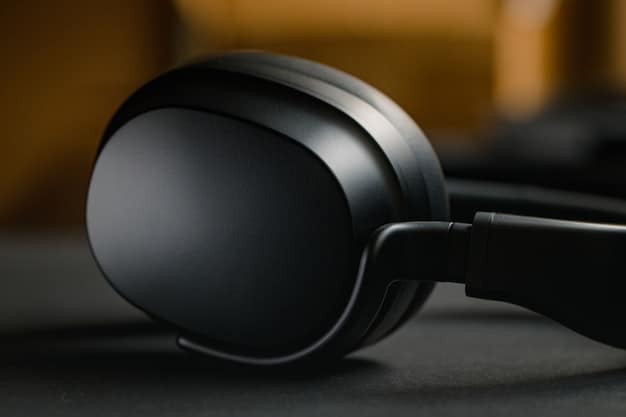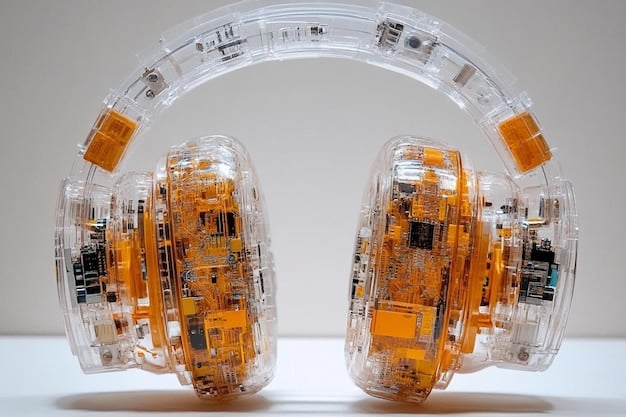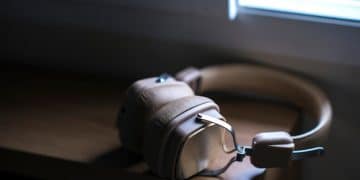Noise-Canceling Headphones: $350 Investment in 2025? (Review)

Investing $350 in noise-canceling headphones in 2025 is justifiable for many, offering significant improvements in focus, travel comfort, and audio immersion through advanced technology and personalized features, making them a valuable purchase for specific user needs despite the premium price.
In a world brimming with digital distractions and constant chatter, the promise of quiet solitude is more appealing than ever. This is where noise-canceling headphones become a serious consideration for many, prompting the question: are noise-canceling headphones worth the $350 investment in 2025? A data-driven review reveals an evolving market where premium features often justify the price tag for those seeking an escape from auditory chaos.
The evolution of noise cancellation technology
Noise-canceling technology has come a long way since its inception, moving from rudimentary sound dampening to sophisticated digital signal processing. In 2025, these advancements are not just about muting background hums; they’re about creating personalized soundscapes, adapting to ambient noise in real-time, and seamlessly blending user preferences with environmental conditions.
Initially, active noise cancellation (ANC) primarily targeted low-frequency, consistent sounds, like airplane engine hums. The technology worked by using microphones to pick up ambient noise, then generating an “anti-noise” sound wave that effectively canceled out the unwanted sound. While effective for repetitive sounds, early ANC struggled with sudden, high-frequency noises or human voices.
Advances in adaptive ANC
Modern noise-canceling headphones often feature adaptive ANC, which utilizes advanced algorithms and multiple microphones to analyze the sound environment continuously. This allows the headphones to adjust the level and type of noise cancellation in real-time. For instance, some models can differentiate between speech and general background noise, allowing users to converse without removing their headphones, or automatically reduce cancellation in quieter environments to preserve battery life.
- Multi-microphone arrays: Enhanced microphone setups capture a wider range of frequencies and angles.
- AI-powered algorithms: Machine learning helps differentiate various sound types and optimize cancellation profiles.
- Personalized sound profiles: Some headphones now learn user preferences and sound environments over time.
These sophisticated systems are not just about hardware; software innovation plays a crucial role. Firmware updates continually refine the technology, often adding new features and improving performance over the device’s lifespan. This ongoing development means a $350 investment today might yield even better performance tomorrow.
Ultimately, the evolution of this technology means a more immersive and less fatiguing listening experience. For professionals needing deep focus, travelers seeking tranquility, or audiophiles demanding pristine sound, these advancements underscore the value proposition of premium models.
Beyond silence: sound quality and features
While noise cancellation is the headline feature, the overall audio experience and a suite of additional functionalities significantly contribute to the perceived value of high-end headphones. A $350 price tag in 2025 isn’t just buying quiet; it’s buying a comprehensive audio ecosystem.
Sound quality, often a subjective metric, benefits immensely from premium components and careful acoustic engineering. Large, custom-tuned drivers, high-resolution audio codec support (like LDAC or aptX Adaptive), and advanced digital-to-analog converters (DACs) are common in this price bracket. These elements combine to deliver a richer, more detailed soundstage, with clear highs, robust mids, and deep, controlled bass, a stark contrast to the often muddier output of cheaper alternatives.
High-resolution audio and spatial sound
The push for high-resolution audio continues, with streaming services offering lossless formats becoming increasingly common. Premium headphones are designed to take full advantage of these sources, providing an audio experience that captures the nuances and fidelity intended by artists. Moreover, spatial audio technology, which creates an immersive, multi-dimensional sound experience, is becoming more prevalent. This feature can dynamically track head movements, making music or movies feel like they’re coming from all around you, similar to a high-end home theater system.
- Lossless codec support: Ensures optimal audio transmission from hi-res sources.
- Dynamic spatial audio: Enhances immersion for media consumption.
- Customizable EQ: Allows users to tailor sound to their personal preferences.
The “features” aspect extends far beyond just sound. Modern headphones integrate seamlessly into our digital lives. Multi-device connectivity, allowing quick switching between a laptop and a phone, is standard. Intuitive touch controls, voice assistant integration (Siri, Google Assistant, Alexa), and customizable app ecosystems offer a personalized and convenient user experience. Features like “ambient sound mode” or “transparency mode” are also crucial, letting users hear their surroundings without removing their headphones, enhancing safety and convenience.
All these elements – superior sound reproduction, high-fidelity codec support, spatial audio, smart features, and robust companion apps – collectively elevate a $350 pair of headphones from a mere gadget to an indispensable personal audio companion, justifying the investment for discerning users.
The battery life puzzle: performance versus longevity

Battery life remains a critical factor in the value proposition of noise-canceling headphones, especially for premium models. While advancements in power efficiency have allowed for longer listening times, the intricate features packed into a $350 pair often demand more energy, creating a delicate balance between performance and longevity.
In 2025, a good pair of noise-canceling headphones in this price range offers impressive battery endurance. Many models boast 25-35 hours of playback with ANC enabled, and even more without. This substantial jump from earlier generations is a result of more efficient chipsets, optimized battery management systems, and improved battery chemistry. For long-haul flights or extended work sessions, this means fewer interruptions and greater reliability.
Fast charging and wireless convenience
Beyond raw capacity, charging solutions have also evolved considerably. Fast charging capabilities are almost expected, where a 10-minute charge can provide several hours of playback. This is incredibly useful for those moments when you’re about to head out and realize your headphones are nearly dead. Furthermore, wireless charging via Qi standard integration is becoming more common, adding a layer of convenience and reducing cable clutter. This feature, while not revolutionary, significantly enhances the user experience by making recharging effortless.
- Extended playtime: 25-35 hours with ANC for most premium models.
- Rapid charge: Quick top-ups for immediate use.
- Qi wireless charging: Enhanced convenience and decluttering.
However, the integration of advanced features such as adaptive ANC, high-resolution audio codecs, spatial audio processing, and extensive microphone arrays does consume more power. This means that while battery technology improves, the power demands of new features grow alongside it, presenting an ongoing engineering challenge. Manufacturers must continuously innovate to deliver both cutting-edge performance and satisfactory battery life. For the consumer, understanding their usage patterns – how often they’ll use ANC, spatial audio, or take calls – is key to evaluating whether the advertised battery life meets their real-world needs.
Ultimately, a $350 investment in 2025 implies not just excellent noise cancellation and sound, but also a reliable and convenient power solution that supports all these advanced capabilities without constantly needing a recharge. The performance-to-longevity ratio is a key determinant of satisfaction and long-term value.
Comfort and build quality: lasting value
The tangible aspects of comfort and build quality contribute significantly to the long-term value of a $350 pair of noise-canceling headphones. Unlike purely technical specifications, these are features that directly impact daily usability and durability, ensuring that the investment provides enduring satisfaction.
Comfort is paramount, especially for headphones designed for extended wear during commutes, flights, or work sessions. Premium models typically utilize high-quality materials for earcups and headbands, such as memory foam, protein leather, or breathable fabrics, which minimize pressure points and heat buildup. The clamping force is meticulously engineered to provide a secure fit without causing discomfort, and the overall weight distribution is balanced to reduce strain on the head and neck. These design considerations are often the result of extensive ergonomic research and user testing, distinguishing them from their lower-priced counterparts.
Premium materials and robust construction
Build quality speaks to durability and longevity. A $350 pair of headphones is expected to withstand daily rigors, including being tossed into bags, worn in various environments, and handled frequently. This means using robust, yet lightweight, materials for the frame—often a combination of high-grade plastics, reinforced metals (like aluminum or steel), and durable hinges. The cabling, if any, is usually braided or reinforced to prevent fraying, and connections are designed to be resilient. Many premium headphones also come with sturdy carrying cases, further protecting the investment during travel.
- Ergonomic design: Ensures comfort for prolonged listening sessions.
- High-quality earcup materials: Memory foam, protein leather enhance comfort and seal.
- Durable frame construction: Combination of reinforced plastics and metals for longevity.
Furthermore, a premium price often translates to better quality control in manufacturing, reducing the likelihood of defects. Investing in a brand known for its reliability and customer support can also provide peace of mind. While accidents can happen, a well-built pair of headphones is more likely to survive minor drops and daily wear and tear, serving its owner for years rather than months. This commitment to materials, craftsmanship, and ergonomic design is not merely an aesthetic choice; it’s a functional one, directly impacting how long and how comfortably you can enjoy your audio, thereby solidifying the justification for the $350 expenditure.
The true cost: comparing with alternatives
When considering an investment of $350 in noise-canceling headphones in 2025, it’s crucial to contextualize this cost by comparing it with available alternatives across different price points and form factors. This analysis helps determine if the premium is truly justified by superior performance and features or if comparable value can be found elsewhere.
At the lower end of the spectrum (under $100), you’ll find basic noise-canceling headphones that offer rudimentary ANC, often cutting out only the lowest frequencies and struggling with mid-range and higher-pitched sounds. Sound quality tends to be acceptable but lacks the detail and richness of premium models. Build quality may feel flimsier, and comfort for extended wear can be an issue. These are suitable for occasional, light use where pristine audio or deep quiet isn’t the primary concern.
Mid-range options and true wireless earbuds
The mid-range ($100-$250) offers a significant step up. Here, you’ll find headphones with respectable ANC, often good sound quality, and better comfort. Brands compete fiercely in this segment, offering a compelling blend of features for a more accessible price. Some true wireless earbuds with ANC also fall into this category, providing greater portability but often at the expense of battery life and overall soundstage compared to over-ear headphones. While these options are excellent value for many consumers, they typically don’t match the top-tier performance in terms of noise cancellation effectiveness, audio fidelity, or material quality found in the $350 segment.
- Budget headphones (<$100): Basic ANC, acceptable sound, limited comfort.
- Mid-range headphones ($100-$250): Good ANC, improved sound, better comfort, viable true wireless ANC options.
- $350+ headphones: Elite ANC, superior audio, premium comfort & build, advanced features.
The $350+ segment, where the leading models reside, represents the pinnacle of current headphone technology. These headphones deliver best-in-class noise cancellation, often with adaptive and personalized features. Audio quality is typically exceptional, aiming for an audiophile-grade experience. Premium materials, superior ergonomics, advanced battery management, and cutting-edge features like spatial audio or robust companion apps are standard. The “true cost” isn’t merely the sticker price, but the total ownership experience – diminished fatigue, enhanced productivity, and pure listening pleasure that often justifies the premium for those who value these aspects highly within their daily lives.

User scenarios: who benefits most?
Understanding who benefits most from a $350 investment in noise-canceling headphones in 2025 is key to determining their worth. This premium price point typically targets specific user groups for whom the advanced features deliver tangible, significant advantages over cheaper alternatives.
Frequent travelers: This group remains a primary beneficiary. The ability to effectively block out engine noise on planes, trains, and buses, as well as the chatter in airports and stations, transforms travel fatigue into a more relaxing or productive experience. For long-haul flights, the supreme comfort and extended battery life of high-end models are indispensable, allowing for hours of uninterrupted music, podcasts, or sleep.
Professionals and students seeking focus
Remote workers and office professionals: In open-plan offices or busy home environments, noise-canceling headphones are a powerful tool for concentration. They create a personal quiet zone, reducing distractions from colleagues, household noises, or street sounds. For those who spend hours on video calls, superior microphone arrays and clear audio transmission become critical, offering a professional edge and minimizing communication hiccups.
- Deep-focus workers: Enhance concentration in distracting environments.
- Commuters: Transform noisy travel into peaceful transit.
- Audiophiles: Experience music with unparalleled fidelity and immersion.
Students: Similar to professionals, students studying in dorms, libraries, or noisy cafes can greatly benefit. The headphones provide a sanctuary for focused study, improving retention and reducing stress from external stimuli. The long battery life ensures they last through an entire day of classes and study sessions.
Audiophiles and content creators: For individuals who prioritize audio fidelity, the advanced sound engineering and high-resolution codec support of $350 headphones are a clear draw. Content creators, particularly those editing audio or video, appreciate the accurate sound reproduction, which allows for more precise work. The immersive spatial audio features found in some models also appeal to movie enthusiasts and casual gamers, providing a heightened sense of presence.
In essence, if your daily life involves constant noise exposure, demands sustained focus, or if you simply value an uncompromised audio experience, the $350 investment transcends a mere gadget purchase, becoming a tool for enhanced well-being, productivity, and enjoyment.
The environmental perspective and future trends
In 2025, the environmental footprint and future trends in technology are increasingly influencing consumer decisions, even for premium gadgets like noise-canceling headphones. A $350 investment isn’t just about immediate gratification; it’s also about a product’s long-term sustainability and adaptability to emerging innovations.
Manufacturers in the high-end audio space are slowly but surely adopting more eco-friendly practices. This includes using recycled plastics and metals in construction, reducing packaging size and weight, and eliminating single-use plastics. Some brands are also focusing on modular designs to facilitate easier repairs and component replacements, extending the product’s lifespan and reducing electronic waste. Consumers are becoming more conscious of these efforts, with sustainable practices potentially adding to the perceived value of a premium product.
Emerging trends: AI integration and health features
Looking ahead, future trends will likely see even deeper integration of AI. Personalized noise cancellation could become even more sophisticated, learning individual hearing profiles and preferred sound environments. AI might also play a larger role in sound customization, dynamically adjusting EQ based on genre, listening volume, or even mood.
- Sustainable manufacturing: Use of recycled materials and reduced waste.
- Modular designs: Enhanced repairability and extended product lifespan.
- Advanced AI: Hyper-personalized sound and noise cancellation.
- Health monitoring: Potential integration of biometric sensors.
Beyond audio, there’s growing interest in integrating health-monitoring features into headphones. While still in nascent stages for over-ear models, future iterations might include sensors for heart rate, body temperature, or even stress levels, turning headphones into wearable health tech. This could open up entirely new use cases, such as guided meditation with biofeedback or improved fitness tracking.
Another emerging area is open-ear audio, which allows users to hear their surroundings while simultaneously listening to audio. While currently niche, this technology could evolve to offer a sophisticated blend of awareness and immersion, potentially offering an alternative or complement to traditional noise cancellation for specific tasks or environments. While these future features might not be fully mature by 2025, the $350 headphones today are built on platforms capable of supporting software updates and, in some cases, hardware upgrades that can embrace these next-gen functionalities, safeguarding the long-term relevance of the investment.
| Key Point | Brief Description |
|---|---|
| 🎧 ANC Evolution | Adaptive, real-time noise cancellation for varied environments. |
| ✨ Sound & Features | High-res audio, spatial sound, smart controls & multi-device connectivity. |
| 🔋 Battery Life | 25-35 hours with ANC, fast charging, and wireless options. |
| 🌎 Future Trends | Sustainability, AI integration, and potential health sensors. |
Frequently asked questions about noise-canceling headphones
The higher cost is due to advanced technologies like adaptive ANC, multiple microphones, sophisticated digital signal processing, premium audio components for high-fidelity sound, and robust build materials. Extensive research, development, and stringent quality control also contribute to the price of top-tier models, ensuring superior performance and durability.
No, noise-canceling headphones significantly reduce ambient noise but typically don’t block all sounds completely. They are most effective at canceling consistent, low-frequency sounds like engine hums. Higher-frequency, sudden, or irregular sounds (like human voices or alarms) are attenuated but often still audible, though less intrusive.
No, active noise cancellation itself is generally not bad for your ears. It works by generating opposing sound waves, not by creating harmful pressure. In fact, by reducing background noise, ANC can help you listen at lower volumes, potentially protecting your hearing from damage caused by excessively loud audio in noisy environments.
Spatial audio creates an immersive, three-dimensional soundscape by processing audio signals to simulate sounds coming from different directions around the listener. Advanced systems use head-tracking technology to anchor sounds to a fixed point in virtual space, even as the user moves their head, enhancing realism for movies and music.
Generally, yes. Premium noise-canceling headphones, particularly those in the $350 range, often use higher-quality materials such as reinforced plastics, metals, and durable fabrics in their construction. They also undergo more rigorous testing and have better quality control, contributing to a longer lifespan and greater resistance to wear and tear compared to cheaper alternatives.
Conclusion
The question of whether noise-canceling headphones are worth the $350 investment in 2025 boils down to individual priorities and usage patterns. A data-driven review confirms that this price point delivers a sophisticated blend of cutting-edge active noise cancellation, superior audio fidelity, robust build quality, and an array of smart features that significantly enhance the user experience. For frequent travelers, dedicated professionals, students seeking focus, and discerning audiophiles, the enhanced comfort, immersive sound, and ability to carve out a personal oasis of quiet often render the investment invaluable. While more affordable options exist, they rarely match the comprehensive performance and lasting reliability of their premium counterparts. Therefore, for those who value an uncompromised audio journey and genuine peace in a noisy world, $350 in 2025 for top-tier noise-canceling headphones is a justifiable and worthwhile expenditure.





